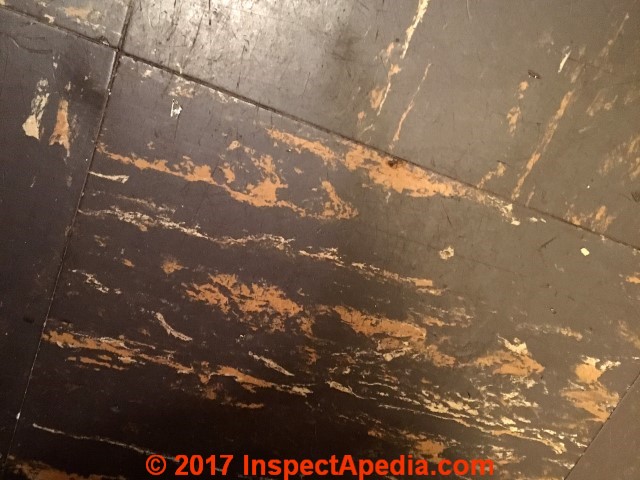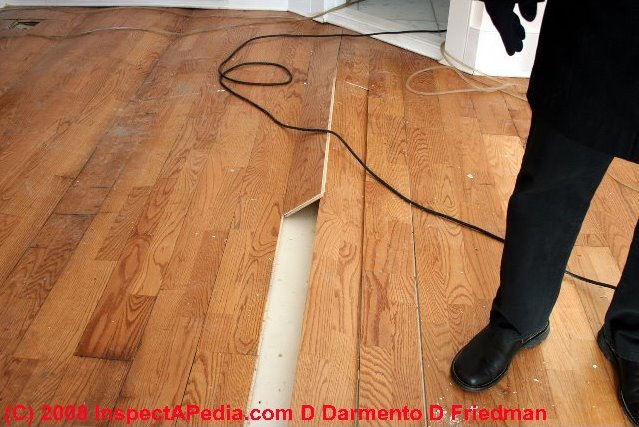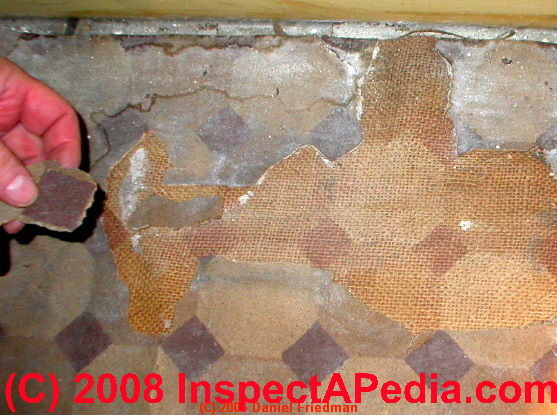 Age of Building Flooring
Age of Building Flooring
First use & last use of each type of flooring material
- POST a QUESTION or COMMENT about how to determine the age of building flooring materials & how to infer the age of a building & its components
Determine the age & composition of building flooring materials & floor coverings:
This article provides a guide to estimating the age of all types of flooring materials in buildings as a guide to determining building age.
The age of a building can be determined quite accurately by documentation, but when documents are not readily available, visual clues such as those available during a professional home inspection can still determine when a house was built.
Page top photo: jute backed Linocrusta sheet flooring.
InspectAPedia tolerates no conflicts of interest. We have no relationship with advertisers, products, or services discussed at this website.
- Daniel Friedman, Publisher/Editor/Author - See WHO ARE WE?
Flooring Materials as Indicators of Building Age
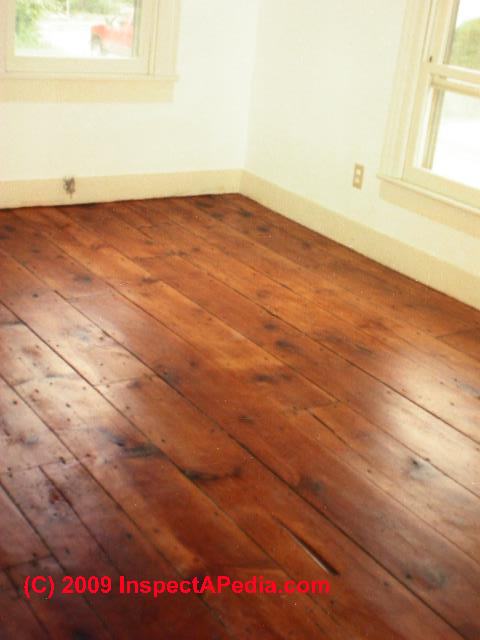 List & History Resilient Floor Coverings Used in buildings
List & History Resilient Floor Coverings Used in buildings
In this flooring age determination article we list some helpful clues using an inspection of interior flooring materials to help answer the question "how old is the house?" and we provide photographs of key visual clues useful for determining the age of a building.
We describe all resilient floor coverings include organic flooring materials such as asphalt tile, cork tile, linoleum, rubber flooring, vinyl tile, vinyl sheet flooring.
Article Contents
- ASPHALT & ASPHALT ASBESTOS FLOOR TILES - 1920 - 1974
- CORK FLOORING & FLOOR TILES - 1900 - present
- VINYL & VINYL ASBESTOS FLOOR TILES - 1970's & later
- LAMINATE WOOD & other LAMINATE FLOORING - 1977 to present
- NON-RESILIENT FLOOR COVERINGS
- SHEET FLOORING MATERIALS - ca 1910 - present
- TABLE of FLOORING MATERIALS & AGES
Photo above: a wide board heart pine floor restored by the author in an 1860's home in Wappingers Falls, New York. The original floor in this home in "the Bleachery" had been covered with multiple layers of linoleum and finally, carpeting.
For still older floor coverings dating before 1950, see this separate article: FLOOR COVERINGS: 1900 - 1949 - older types of floor coverings, sheet linoleum, congoleum, & tiles
Asphalt Tile Flooring as an Indicator of Building Age - 1920 - 1974 (est)
In 1920 asphalt roofing manufacturers, who had been using asphalt and fiber binders to make asphalt roofing shingles for some time, tried to develop a rigid product that could be a substitute for (more costly) slate roofing.
The material did not perform acceptably as a roof covering, but it led to the development of asphalt floor tiles.
Asphalt floor tiles are 9" square (or other sized) tiles which used asphalt as the main binding material. the original asphalt tiles were produced only in dark colors because asphalt was a main ingredient.
Rosato indicates that the first publicized asphalt tile installation was in 1920 in New York City's Western Union office.
The product was very successful and by 1936 over four million square yards of asphalt floor tiles were being sold annually. By 1940, 5% of floor coverings sold in the U.S. were asphalt tile. -- Rosato
In the U.S. the 1940's saw a tremendous expansion in the sales of this flooring material, largely because other materials were more difficult to obtain.
At the end of World War II and combined with the reduction in military consumption of the product, asphalt floor tile sales increased to about 12% of the flooring market (1946), selling 41 million square yards. By 1949 the post-war construction boom led to asphalt floor tile sales of 61 million square yards.
By 1952 "asphalt-asbestos" floor tiles contained much less asphalt or gilsonite. Those binders produced only dark tiles. IN the 1950's manufacturers changed to use of synthetic organic resins and solvents made of vegetable or petroleum pitches
. These new synthetic binders permitted manufacture of lighter colored, brighter floor tiles in a wider range of colors. But asbestos continued to be the main filler ingredient in these tiles.
Vinyl asbestos floor tiles were produced from approximately 1954 to 1980. Early vinyl asbestos flooring was made in 9" x9" floor tiles, and also sold as decorative or accent solid color strips, typically 1" wide by 24" long. By 1960 12" x 12" vinyl asbestos floor tiles were produced by Armstrong™, particularly their Excelon™ line. Asbestos was also used in sheet flooring.
By 1973 only a small portion of flooring was produced as asphalt-based floor tiles (9"x9") as vinyl asbestos flooring was dominating production. The size, thickness, color, and patterns of floor tiles can distinguish between asphalt-asbestos and vinyl-asbestos flooring.
While asbestos-containing floor tiles were made in a wide variety of colors and patterns, if you encounter black or very dark asphalt floor tiles they are probably particularly high in asbestos fibers.
See ASBESTOS FLOOR TILE PHOTO ID GUIDE
We discuss floor tiles as an asbestos fiber source in buildings in more detail
at ASBESTOS FLOORING IDENTIFICATION.
Colors and Patterns of Resilient Floor Tiles Can Indicate When They Were Produced
Asphalt -asbestos tiles manufactured early in their life (1920's) were either black, near black, brown, or a gray-brown tone.
Brown asphalt-asbestos tiles were made by substituting gilsonite as a binder. In both cases the tiles were hardened by evaporating a solvent used in the fabrication process, or by cooling of hot asphalt used in the mixture.
Gilsonite could be used to produce a wider range of mixtures, but required some asphalt as a softener.
Dark vinyl-asbestos tiles used, for example, a mixture of 40 parts asphalt or gilsonite, 60 parts asbestos floats, 30 parts powdered limestone, and pigments (parts by weight). Another typical mixture cited by Rosato contained 70% asbestos fiber.
See these articles on asphalt and vinyl-asbestos floor tile identification:
- ASBESTOS FLOORING IDENTIFICATION - How to Identify Floor Tiles That May Contain Asbestos
- ASBESTOS FLOOR TILE IDENTIFICATION PHOTOS 1949-1959 - detailed photo guide to asphalt asbestos and vinyl asbestos floor tiles, 1900 -1986
- FLOOR TILE HISTORY & INGREDIENTS - history, dates, and description of the production process and ingredients in asphalt floor tiles, asphalt-asbestos floor tiles, & vinyl-asbestos floor tiles 1900 to present.
- ASBESTOS FLOOR TILE LAB PROCEDURES - photos of how vinyl asbestos flooring is analyzed in the lab
- FLOORING MATERIALS, Age, Types - Age of Building Flooring Materials - A Guide to Estimating Building Age
Cork Floor Tiles or Cork Planks as an Indicator of Building Age
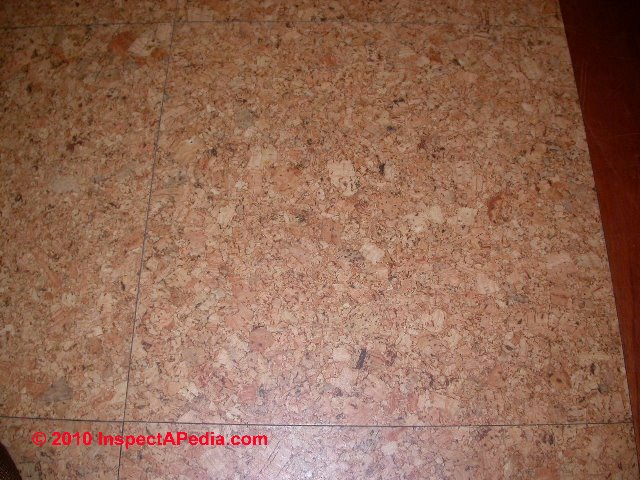 Cork was one of the first resilient floor materials, ca 1900, it continues in use to the present day.
Cork was one of the first resilient floor materials, ca 1900, it continues in use to the present day.
Cork floors, real cork flooring, were and are a wood product made out of cork from the cork oak tree (Quercus suber) native to Mediterranean countries, primarily Spain and Portugal.
The bark of the cork oak is or was harvested once every nine or ten years, without injuring the tree. The epitome of a resilient floor, cork flooring can compress up to 40% and still return to its original shape.
Armstrong Cork Floor Tiles
In the U.S. Thomas Armstrong, a Scotch-Irish immigrant, began his business as a cork cutter in 1860, delivering hand-carved bottle corks by wheelbarrow.
The use of cork expanded to the construction of corkboards (bulletin boards) and cork-insulated brick.
By 1909 Armstrong had begun producing linoleum. "Corkboard led to fiberboard, fiberboard led to ceiling board, cork floor tile led to linoleum that ultimately led to vinyl floor coverings, in both tile and sheet vinyl forms.
Armstrong's familiarity with cork grew into today's Armstrong Corporation worldwide as one of the largest flooring producers.
See Armstrong flooring history.
Dodge Cork Floor Tiles
The Dodge Cork Company, a second Lancaster PA flooring company, also has a long history in floor covering production, dating from its founding in 1926.
Dodge Cork notes that their cork floors were used by Frank Lloyd Wright at Falling Waters and of course in many other buildings and that the company was producing a million square feet of cork floor tiles a month by 1962, probably a peak in the cork floor market.
Details about cork flooring are at CORK FLOORING.
Laminate Flooring: Determining the Age of buildings Using Laminate Flooring Products
Contemporary snap-together flooring products that resemble wood or other surfaces, but are made of plastic, and other pre-finished and ready-to-assemble wood flooring products are a much more modern product.
Sadly the laminate floor shown at left was ruined by a building flood.
Pergo™ laminate flooring, for example, was developed by Pergo AB, a Swedish company founded around 1890 as a vinegar manufacturer. Product development for Pergo laminate flooring began in 1977 and was first brought to the market in 1984.
Pergo laminate flooring was first sold in the U.S. in 1994.
It's safe to say that if you see a Pergo™ product in building in U.S. the flooring was installed no longer ago than 1994.
But because this product is has been widely used as a renovation material installed atop older preexisting finish floor surfaces, one should not presume that the product age is the same as the building age unless the floor was installed as original material - that is, unless it was not installed over an older floor covering.
Just seeing Pergo™ laminate flooring over a plywood subfloor is not sufficient data to conclude the age of a home. Older carpeting may have been removed to expose a plywood subfloor over which the laminate flooring was then installed.
Keep in mind that even when we can identify specific types of building materials and building methods, precise dating of the time of construction of a building remains difficult: old building materials were often re-used, so beams, siding, and other components may appear in a building built later than when the materials were first made.
Also, in the U.S. various states had machines for making cut nails, screws, and sawmills at different times. For example, New York State was industrialized earlier than some western or southern states, so machine-made nails appear earlier in New York than elsewhere.
Details about laminate flooring and wood laminate floors are at
- LAMINATE PLASTIC FLOORING
- LAMINATE WOOD & Other Laminate Floors
- WOOD FLOORING & Engineered Wood Floors
Age of Linoleum Flooring & Older Sheet Flooring Materials Indicate Age of a Building (1890 - 1960 est)
Above is Congoleum Gold Seal Jackstraw pattern, below, Congoleum "Square Dance" sheet linoleum sold in a 9" x 9" tile pattern.
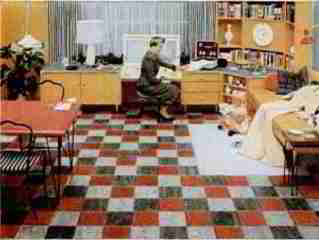
Prior to the development of linoleum sheet flooring, floor coverings were made of painted canvas. According to Rosato, "The original resilient floor coverings were developed during the latter part of the Nineteenth Century by Frederick Walton.
The original covering was linoleum for use as a floor decking on British naval ships." The composition of the original products included asphaltic binders to which an asbestos filler was added by mixing on a rubber mill.
As discussed at ASBESTOS FLOOR TILE IDENTIFICATION PHOTOS 1949-1959 that Linoleum may be used as a generic term for older sheet floorings (sometimes incorrectly). Linoleum was invented as a ship deck, later floor covering in 1860 by Frederick Walton to describe sheet flooring.
This article explains various common flooring materials (rough wood, finished wood, parquet, carpeting, Linocrusta, sheet vinyl, and other items as they assist in determining The age of a building or other building.
Details about linoleum flooring products and the history and ingredients of linoleum are found
Also see CONGOLEUM FLOORING HISTORY
and RESILIENT SHEET FLOORING ID GUIDE
Details about the history of Sheet and Tile Resilient flooring are also discussed
at FLOOR TILE HISTORY & INGREDIENTS.
Vinyl Asbestos Floor Tiles as an Indicator of Building Age - 1954 - 1983 (est)
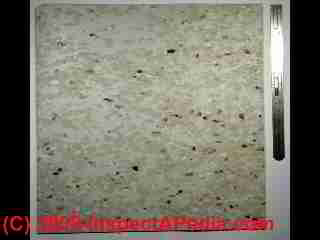 Vinyl floor tiles, including vinyl-asbestos floor tiles and homogeneous vinyl floor tiles (non-asbestos product) are almost as old as asphalt floor tiles. By the early 1950's in the U.S. vinyl tile floor products were more popular than asphalt-based flooring. The reason is pretty obvious.
Vinyl floor tiles, including vinyl-asbestos floor tiles and homogeneous vinyl floor tiles (non-asbestos product) are almost as old as asphalt floor tiles. By the early 1950's in the U.S. vinyl tile floor products were more popular than asphalt-based flooring. The reason is pretty obvious.
Asphalt-based flooring as it was originally produced used heavy asphalt products which meant that the floor tiles could be made in dark colors only.
Soon after asphalt-asbestos floor tiles were marketed manufacturers heard from their buyers that consumers wanted lighter floor tiles and tiles of varying color and pattern.
Organic resin vinyl increased in popularity for this reason, but slowly. By 1952, the production of vinyl plastic floor tile sales in the U.S. was about half the volume of asphalt floor tiles, selling 35 million square yards.
Micro photographs of vinyl-asbestos floor tiles can be seen at our article
at ASBESTOS FLOORING IDENTIFICATION. -- Rosato
See these articles on asphalt and vinyl-asbestos floor tile identification:
- Vinyl-Asbestos Floor Tile HISTORY
- Vinyl Asbestos Floor Tile PACKAGING
- Vinyl Asbestos Floor THICKNESS & DIMENSIONS
- Vinyl Asbestos SHEET FLOORING
Also see
- ASBESTOS FLOORING IDENTIFICATION - How to Identify Floor Tiles That May Contain Asbestos
- ASBESTOS FLOOR TILE IDENTIFICATION PHOTOS 1949-1959 - detailed photo guide to asphalt asbestos and vinyl asbestos floor tiles, 1900 -1986
- FLOOR TILE HISTORY & INGREDIENTS - history, dates, and description of the production process and ingredients in asphalt floor tiles, asphalt-asbestos floor tiles, & vinyl-asbestos floor tiles 1900 to present.
- ASBESTOS FLOOR TILE LAB PROCEDURES - photos of how vinyl asbestos flooring is analyzed in the lab
- FLOORING MATERIALS, Age, Types - Age of Building Flooring Materials - A Guide to Estimating Building Age
Non-Resilient Floors Used in buildings
Examples of non-resilient flooring used in buildings include
- Ceramic Tile Floors
- Concrete Floors including stained, colored, textured, or specially-finished concrete floor surfaces
- Wood Floors (more just below) including strip wood flooring and parquet floors
detailed at PARQUET WOOD / VINYL FLOORING
Wood Floors Used in buildings - Indicators of Building Age

The list of flooring types by wood species, widths, thickness, edge types (square, ship lap, tongue & groove), and the history and age of the use of these products in buildings is enormous.
Here we collect and provide photographs of a collection of wood flooring types as an aid to flooring restorers, preservationists, and inspectors wishing to determine the age of a building and its materials.
Please see WOOD FLOOR TYPES for a detailed inventory of types and eras of use of various types of wood flooring such as wide board wood floors, solid strip flooring, solid short-strip flooring, and pre-finished wood floor materials.
We also distinguish between square-edged solid floor boards, shiplap edged flooring, and tongue-and groove flooring among older types of solid wood floors and subfloors.
The shiplap-edged solid sideboard floor floor shown in our photo (left) was in an 1860's frame home restored by the author.
Also See WOOD FLOOR CAMAGE
Age of Flooring Materials Based on Eras of Common Usage
Below we include (for now) flooring materials that have come into popular use in the last 250 years. Some basic flooring materials and floor coverings such as stone, slate, brick, carpets and tapestry have a much older history.
This table is incomplete as there were thousands of flooring designs and models; contributions or comments welcomed (CONTACT) - Ed.
Table of Manufactured Building Flooring Materials |
||||
|---|---|---|---|---|
Flooring Product Name or Type |
Years of Common Usage | Sizes | Thick-ness | Comments & References |
Asphalt-Asbestos sheet flooring |
1910 - 19751,2 | ASBESTOS FLOOR TILE IDENTIFICATION PHOTOS 1949-1959 ASBESTOS FLOOR TILE IDENTIFICATION PHOTOS 1949-1959 ASBESTOS FLOORING HAZARD REDUCTION |
||
Asphalt-asbestos floor tiles |
1920 - 19751,2 | 6x6" 9x9" 12x12" |
1/8-1/2" | 1930 began replacing linoleum ASBESTOS FLOORING HAZARD REDUCTION ASBESTOS FLOORING REMOVAL GUIDE |
Carpeting |
CARPETING, SELECTION & INSTALLATION | |||
Ceramic Tile |
||||
Concrete floor surfaces, finished, stained |
CONCRETE FLOOR FINISH | |||
Cork floor tiles & sheet flooring |
1900 - 19201 | 6x6" 9x9" 12x12" |
||
Cork floor, pre-finished |
19201 - present | 6x6" 9x9" 12x12" |
||
Felt-based sheet flooring |
1910 - 19501 | Congoleum et als. |
||
Laminate Flooring, Plastic |
||||
Laminate wood flooring |
1977 - present | 1977, and as Pergo, first to market in 1985, first sold in U.S. 1994 |
||
Linoleum |
1863 - 1950 | 1/8-1/2" | ||
Linofloor |
19371 - 1950 | Armstrong |
||
Oilcloth flooring |
17001- 1880 Includes painted canvas |
FLOOR COVERINGS: 1900 - 1949 | ||
Resilient Flooring, general |
1200(early rubber) to present |
RESILIENT SHEET FLOORING ID GUIDE |
||
Rubber sheet flooring, natural |
19241 - 1942 |
Raised disc sheet rubber, 1950 | ||
Rubber tiles flooring, natural |
1850 - 1942 | Interlocking 2" rubber tiles patented by Frank Furness, Phila. Architect, 18941 |
||
Rubber flooring, synthetic |
19421- present | Mixed with asbestos &/or wood fibers. Some forms resemble vinyl & asphalt flooring.1 |
||
Stone Flooring |
ca 3000 B.C.E. to present | STONE, GRANITE, MARBLE, AGGLOMERATE | ||
Vinyl-Asbestos Floor Tiles |
19331,2 - 1983 | 9x9" 12X12" |
Wide use after 19451,2 ASBESTOS FLOOR TILE IDENTIFICATION PHOTOS 1949-1959 ASBESTOS FLOOR TILE IDENTIFICATION PHOTOS 1949-1959 FLOOR TILE / SHEET FLOORING PHOTO GUIDES (Flintcote below ground use) |
|
Vinyl-Asbestos sheet flooring |
19331,2 - 1983 | RESILIENT SHEET FLOORING ID GUIDE | ||
Vinyl asbestos sheet cushioned flooring |
19601 - 1983 | 1960s: Vinyl laminate adhered to asphalt-saturated felt or cork backing (cushioned vinyl) | ||
Vinyl asbestos sheet no-wax flooring |
19621 - 1983 | ARMSTRONG SOLARIAN NO-WAX FLOORING HISTORY | ||
Wood Flooring |
Solid wood & split log wood floors: 1600 - 1050 B.C.E. 1600 A.D. Sawn wood board floors: 1600 to present Tongue-&-Groove: 1885 to present |
|||
Notes to the table above
- [1] Wilson & Snodgrass (2007).
The MTDC “Facilities Toolbox” (http://www.fs.fed.us/ eng/toolbox/haz/haz02.htm) provides information about ACM in Forest Service facilities.
“Recommended Work Procedures for Resilient Floor Covering,” at http://www.rfci.com/int_ARF-TechInfo. htm. - [2] Rosato (1959)
- [3] McAlester (1984) offers a nano history of bituminous materials used in roofing, sheathing, flooring in North America. Natural tar was used to produce waterproof coverings since colonial times (ca 1760) by impregnating cloth, felt, or paper with bitumen, semi-solid residues of tar and asphalt.
By the late 1800's techniques were developed to convert tar or asphalt into cold roofing by impregnating sheets or shingles of felt, paper, or cloth with bituminous preparations used in turn for roofing, sheathing, and felt underlayment including in flooring products. Roof shingles of asbestos fibers bound with concrete were widely used in the early 1900's. - FLOOR TILE HISTORY & INGREDIENTS
- LINCRUSTA CEILINGS & WALLS
- FLOOR COVERINGS: 1900 - 1949
...
Reader Comments, Questions & Answers About The Article Above
Below you will find questions and answers previously posted on this page at its page bottom reader comment box.
Reader Q&A - also see RECOMMENDED ARTICLES & FAQs
When did vinyl floor tile replace asbestos tile?
When was asbestos tile flooring discontinued in office buildings and replaced with VCT - On 2019-01-30 by Steve Paige -
Reply by (mod) -
Just to be clear, there was never pure asbestos floor tile nor sheet flooring, though asbestos was used as both a fiber and filler in both forms of floor covering; the "when" answer to its discontinuance depends on where you live: at least the country.
Asphalt-asbestos floor tile production continued into the 1960's even when vinyl floor tiles were also being manufactured.
In the U.S. asbestos containing flooring was more or less out of production by the mid 1980's, earlier for some companies.
Please see details at FLOOR TILE HISTORY & INGREDIENTS https://inspectapedia.com/interiors/Floor_Tile_History.php
What type of flooring was put in houses on 1975?
What type of flooring was put in houses on 1975? - On 2018-04-08 by Lillie
Reply by (mod) -
Lillie there were many different types of flooring installed in homes around the world in 1975 ranging from dirt or stone through ceramic tile, marble, wood, carpeting, vinyl sheet flooring, vinyl tile flooring. If we could narrow down the question a bit that might be more useful.
If you are asking whether or not asbestos-containing vinyl floor tile or sheet flooring were in common use in North America in 1975 then yes.
What material was used in mixed pink and purple 1957 floor tiles
My parents had a special floor placed in their den in 1957. The person who did the tile evidently mixed the colors which are pink and purple! individually for each tile as the laid each one. None are exactly the same.
Its very tough and has lasted all these years except for the fact that it is very dirty now and can't seem to be cleaned.
Do you have any idea what it might be? - On 2016-03-18 by Alice Hess
Reply by (mod) -
Sorry, Alice, no I don't . From just naming the colors of flooring I can't guess what material was used. But in the 1950s it was common to install asphalt-asbestos floor tiles.
Examples are at ASBESTOS FLOOR TILE IDENTIFICATION PHOTOS 1900 -1950s
...
Continue reading at FLOOR TILE HISTORY & INGREDIENTS - history, dates, and description of the production process and ingredients in asphalt floor tiles, asphalt-asbestos floor tiles, & vinyl-asbestos floor tiles, or select a topic from the closely-related articles below, or see the complete ARTICLE INDEX.
Or see these
Recommended Articles
- AGE of a BUILDING, HOW to DETERMINE
- ASBESTOS FLOORING IDENTIFICATION - How to Identify Floor Tiles That May Contain Asbestos
- ASBESTOS FLOOR TILE IDENTIFICATION PHOTOS 1949-1959 - detailed photo guide to asphalt asbestos and vinyl asbestos floor tiles, 1900 -1986
- DAMAGE DIAGNOSIS for FLOORS
- FLOOR COVERINGS: 1900 - 1949 - older types of floor coverings, sheet linoleum, congoleum, & tiles
- FLOOR TILE ASBESTOS IDENTIFICATION
- FLOOR TILE / SHEET FLOORING PHOTO GUIDES - list of photo guides
- FLOOR TILE HISTORY & INGREDIENTS - history, dates, and description of the production process and ingredients in asphalt floor tiles, asphalt-asbestos floor tiles, & vinyl-asbestos floor tiles 1900 to present.
- FLOORING MATERIALS, Age, Types - Age of Building Flooring Materials - A Guide to Estimating Building Age, This article describes types and ingredients in flooring materials: Asphalt floor tile, Cork floor tile or planks, Laminate flooring (modern), Linoleum & older sheet flooring (painted canvas), Vinyl-asbestos floor tiles, Wood flooring.
- FLOOR TYPES & DEFECTS - Asphalt floor tiles, asphalt-saturated asbestos felt, carpeting, cork floor tiles & planks, laminate flooring (modern), linoleum (sheet flooring) & earlier painted fabric floor coverings, vinyl-asbestos tile floors, wood flooring.
Suggested citation for this web page
FLOORING MATERIALS, AGE, TYPES at InspectApedia.com - online encyclopedia of building & environmental inspection, testing, diagnosis, repair, & problem prevention advice.
Or see this
INDEX to RELATED ARTICLES: ARTICLE INDEX to BUILDING AGE
Or use the SEARCH BOX found below to Ask a Question or Search InspectApedia
Or see
INDEX to RELATED ARTICLES: ARTICLE INDEX to BUILDING INTERIORS
Or use the SEARCH BOX found below to Ask a Question or Search InspectApedia
Ask a Question or Search InspectApedia
Try the search box just below, or if you prefer, post a question or comment in the Comments box below and we will respond promptly.
Search the InspectApedia website
Note: appearance of your Comment below may be delayed: if your comment contains an image, photograph, web link, or text that looks to the software as if it might be a web link, your posting will appear after it has been approved by a moderator. Apologies for the delay.
Only one image can be added per comment but you can post as many comments, and therefore images, as you like.
You will not receive a notification when a response to your question has been posted.
Please bookmark this page to make it easy for you to check back for our response.
IF above you see "Comment Form is loading comments..." then COMMENT BOX - countable.ca / bawkbox.com IS NOT WORKING.
In any case you are welcome to send an email directly to us at InspectApedia.com at editor@inspectApedia.com
We'll reply to you directly. Please help us help you by noting, in your email, the URL of the InspectApedia page where you wanted to comment.
Citations & References
In addition to any citations in the article above, a full list is available on request.
- Armstrong, Portugal: Ingredients of Linoleum, web search 03/31/2011, original source: http://www.armstrong.pt/commflreu/es-pt/ingredients.html
- America's Favorite Homes, mail-order catalogues as a guide to popular early 20th-century houses, Robert Schweitzer, Michael W.R. Davis, 1990, Wayne State University Press ISBN 0814320066 (may be available from Wayne State University Press)
- Carlisle, Alexander M. 1997. Historic linoleum: analysis, cleaning systems, recommendations for preservation. APT Bull. 28(2–3): 37–43. Technical article on conservation of historic linoleum. Cited in Wilson (2007)
- Cole, Regina. 2001. Resilient flooring. Old-House Interiors. 7(1 and 2). (December–January): 84–88. General overview of rubber, vinyl, cork, and linoleum, includes photos and names of manufacturers. Cited in Wilson (2007)
- Dodge Cork Products, 119 South Tree Dr., P.O. Box 4944, Lancaster, PA 17604-4944, Tel: 877-326-7655, Website: http://www.dodgecork.com/ E-mail: requests@dodgecork.com Web search: 04/27/2011
- Ellermann, Heiko. 2000. The restoration and conservation of linoleum. In: Linoleum: History, Design, Architecture: 1882–2000. New York: Distributed Art Publishers: 58–67. Provides a case study on the restoration and conservation of a late 1950s linoleum floor covering.
- Foster, Benjamin R. 2005. From roofing to flooring. Old-House Journal. 33(2). (March–April): 66–69. A short article about the history and manufacture of Congoleum.
- Jester, Thomas C. Twentieth-century building materials. New York: McGraw-Hill. 1995. Individual chapters on linoleum, rubber tile, cork tile, and vinyl tile.
- McAlester, Virginia & Lee, A Field Guide to American Houses, (1984) ISBN-10: 0394739698 ISBN-13: 978-0394739694
- Asbestos Identification, Walter C.McCrone, McCrone Research Institute, Chicago, IL.1987 ISBN 0-904962-11-3. Dr. McCrone literally "wrote the book" on asbestos identification procedures which formed the basis for current work by asbestos identification laboratories.
- Powell, Jane 2003. Linoleum. Layton, Utah: Gibbs Smith. Extensively illustrated book on the history, patterns, and care of linoleum.
- Resilient Floor Covering Institute, 401 East Jefferson Street, Suite 102, Rockville, MD 20850, Tel: 301–340–8580, Website: http://www.rfci.com
- Resilient Floor Covering Institute (RFCI), "Recommended Work Practices for Removal of Resilient Floor Coverings" (May, 2011), Resilient Floor Covering Institute, 115 Broad St., Suite 201, LaGrange, GA 30240, Tel: 706-882-3833, Website: www.rfci.com, retrieved 1/18/2014, original source http://rfci.com/wordpress/wp-content/uploads/2013/06/rfci-rwp-final-oct2011.pdf
- Richa Wilson, Kathleen Snodgrass, EARLY 20TH-CENTURY BUILDING MATERIALS: RESILIENT FLOORING [Very large PDF], Richa Wilson, Intermountain Regional Architectural Historian Kathleen Snodgrass, Project Leader, United States Department of Agriculture Forest Service, Technology & Development Program, August 2007, 7300-0773-2322-MTDC. Contact Kathie Snodgrass at MTDC: Tel: 406–329–3922, Email: ksnodgrass@fs.fed.us or Richa Wilson, author; USDA Forest Service, Intermountain Region, 324 25th Street, Ogden, UT 84401. Phone: 801–625–5704; fax: 801–625–5229: e-mail: rwilson@fs.fed.us
- American Plywood Association, APA, "Portland Manufacturing Company, No. 1, a series of monographs on the history of plywood manufacturing",Plywood Pioneers Association, 31 March, 1967, www.apawood.org
- Armstrong ® Residential Flooring - Website 05/15/2010 https://www.armstrongflooring.com/ lists current flooring products provided by the Armstrong Corporation, including Armstrong's current vinyl floor tile products at https://www.armstrongflooring.com/flooring/products/vinyl-floors
- Armstrong Corporation, Corporate History - https://www.armstrongflooring.com/corporate/corporate-history.html - Web Search 05/19/2010
- Armstrong vinyl asbestos floor tiles: photos of asbestos floor tiles as catalog pages (PDF form) are at www.asbestosresource.com/asbestos/tile.html
- Building Research Council, BRC, nee Small Homes Council, SHC, School of Architecture, University of Illinois at Urbana-Champaign, brc.arch.uiuc.edu. "The Small Homes Council (our original name) was organized in 1944 during the war at the request of the President of the University of Illinois to consider the role of the university in meeting the demand for housing in the United States. Soldiers would be coming home after the war and would be needing good low-cost housing.
- Manufactured & Modular Homes: Modular Building Systems Association, MBSA, modularhousing.com, is a trade association promoting and providing links to contact modular builders in North America. Also see the Manufactured Home Owners Association, MHOAA, at www.mhoaa.us. The Manufactured Home Owners Association of America is a National Organization dedicated to the protection of the rights of all people living in Manufactured Housing in the United States.
- Pergo AB, division of Perstorp AB, is a Swedish manufacturer or modern laminate flooring products. Information about the U.S. company can be found at http://www.pergo.com where we obtained historical data used in our discussion of the age of flooring materials in buildings.
- Thanks to reader Robin DiNunzio for contributing samples of cork flooring from a 1949 home M1y 2010
- America's Favorite Homes, mail-order catalogues as a guide to popular early 20th-century houses, Robert Schweitzer, Michael W.R. Davis, 1990, Wayne State University Press ISBN 0814320066 (may be available from Wayne State University Press)
- Pergo AB, division of Perstorp AB, is a Swedish manufacturer or modern laminate flooring products. Information about the U.S. company can be found at http://www.pergo.com where we obtained historical data used in our discussion of the age of flooring materials in buildings.
- What Style Is It?: A Guide to American Architecture, Rev., John C. Poppeliers, S. Allen Chambers, Wiley; Rev Sub edition (October 6, 2003), ISBN-10: 0471250368, ISBN-13: 978-0471250364
- In addition to citations & references found in this article, see the research citations given at the end of the related articles found at our suggested
CONTINUE READING or RECOMMENDED ARTICLES.
- Carson, Dunlop & Associates Ltd., 120 Carlton Street Suite 407, Toronto ON M5A 4K2. Tel: (416) 964-9415 1-800-268-7070 Email: info@carsondunlop.com. Alan Carson is a past president of ASHI, the American Society of Home Inspectors.
Thanks to Alan Carson and Bob Dunlop, for permission for InspectAPedia to use text excerpts from The HOME REFERENCE BOOK - the Encyclopedia of Homes and to use illustrations from The ILLUSTRATED HOME .
Carson Dunlop Associates provides extensive home inspection education and report writing material. In gratitude we provide links to tsome Carson Dunlop Associates products and services.


